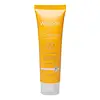What's inside
What's inside
 Key Ingredients
Key Ingredients

 Benefits
Benefits

 Concerns
Concerns

 Ingredients Side-by-side
Ingredients Side-by-side

Sodium Cocoyl Glycinate
CleansingGlycerin
HumectantCocamidopropyl Betaine
CleansingButylene Glycol
HumectantPotassium Cocoyl Glycinate
Water
Skin ConditioningDecyl Glucoside
CleansingHydroxypropyl Starch Phosphate
PEG-400
Emulsion StabilisingSodium Lauroyl Aspartate
CleansingSodium Stearoyl Glutamate
CleansingGlyceryl Stearate Se
EmulsifyingPolyquaternium-52
PEG-32
HumectantCitric Acid
BufferingPolyquaternium-7
Lauric Acid
CleansingStearic Acid
CleansingMethylparaben
PreservativeHydroxypropyltrimonium Hyaluronate
Propylparaben
PreservativeBHT
AntioxidantDisodium EDTA
Hydroxypropyl Methylcellulose
Emulsion StabilisingArctostaphylos Uva-Ursi Leaf Extract
Skin ConditioningSodium Cocoyl Glycinate, Glycerin, Cocamidopropyl Betaine, Butylene Glycol, Potassium Cocoyl Glycinate, Water, Decyl Glucoside, Hydroxypropyl Starch Phosphate, PEG-400, Sodium Lauroyl Aspartate, Sodium Stearoyl Glutamate, Glyceryl Stearate Se, Polyquaternium-52, PEG-32, Citric Acid, Polyquaternium-7, Lauric Acid, Stearic Acid, Methylparaben, Hydroxypropyltrimonium Hyaluronate, Propylparaben, BHT, Disodium EDTA, Hydroxypropyl Methylcellulose, Arctostaphylos Uva-Ursi Leaf Extract
Water
Skin ConditioningEthylhexyl Methoxycinnamate
UV AbsorberButylene Glycol
HumectantCyclopentasiloxane
EmollientDimethicone Crosspolymer
Emulsion StabilisingCaprylyl Methicone
Skin ConditioningCyclomethicone
EmollientIsododecane
EmollientDisteardimonium Hectorite
StabilisingPropylene Carbonate
SolventPolyglyceryl-4 Isostearate
EmulsifyingCetyl PEG/PPG-10/1 Dimethicone
EmulsifyingHexyl Laurate
EmollientStearic Acid
CleansingSilicon
AbrasiveTitanium Dioxide
Cosmetic ColorantDimethicone
EmollientC30-45 Alkyl Dimethicone
Skin ConditioningTriethylhexanoin
MaskingPolymethyl Methacrylate
Sodium Chloride
MaskingCetyl Dimethicone
EmollientEthylhexyl Palmitate
EmollientNiacinamide
SmoothingPhenoxyethanol
PreservativeEthylhexylglycerin
Skin ConditioningSorbitan Olivate
EmulsifyingBHT
AntioxidantAllantoin
Skin ConditioningAscorbyl Tetraisopalmitate
AntioxidantTocopheryl Acetate
AntioxidantTrimethylsiloxysilicate
EmollientDisodium EDTA
Aluminum Hydroxide
EmollientTriethoxycaprylylsilane
Methicone
EmollientCI 77891
Cosmetic ColorantCI 77492
Cosmetic ColorantCI 77491
Cosmetic ColorantWater, Ethylhexyl Methoxycinnamate, Butylene Glycol, Cyclopentasiloxane, Dimethicone Crosspolymer, Caprylyl Methicone, Cyclomethicone, Isododecane, Disteardimonium Hectorite, Propylene Carbonate, Polyglyceryl-4 Isostearate, Cetyl PEG/PPG-10/1 Dimethicone, Hexyl Laurate, Stearic Acid, Silicon, Titanium Dioxide, Dimethicone, C30-45 Alkyl Dimethicone, Triethylhexanoin, Polymethyl Methacrylate, Sodium Chloride, Cetyl Dimethicone, Ethylhexyl Palmitate, Niacinamide, Phenoxyethanol, Ethylhexylglycerin, Sorbitan Olivate, BHT, Allantoin, Ascorbyl Tetraisopalmitate, Tocopheryl Acetate, Trimethylsiloxysilicate, Disodium EDTA, Aluminum Hydroxide, Triethoxycaprylylsilane, Methicone, CI 77891, CI 77492, CI 77491
Ingredients Explained
These ingredients are found in both products.
Ingredients higher up in an ingredient list are typically present in a larger amount.
BHT is a synthetic antioxidant and preservative.
As an antioxidant, it helps your body fight off free-radicals. Free-radicals are molecules that may damage your skin cells.
As a preservative, it is used to stabilize products and prevent them from degrading. Specifically, BHT prevents degradation from oxidation.
The concerns related to BHT come from oral studies; this ingredient is currently allowed for use by both the FDA and EU.
However, it was recently restricted for use in the UK as of April 2024.
Learn more about BHTButylene Glycol (or BG) is used within cosmetic products for a few different reasons:
Overall, Butylene Glycol is a safe and well-rounded ingredient that works well with other ingredients.
Though this ingredient works well with most skin types, some people with sensitive skin may experience a reaction such as allergic rashes, closed comedones, or itchiness.
Learn more about Butylene GlycolDisodium EDTA plays a role in making products more stable by aiding other preservatives.
It is a chelating agent, meaning it neutralizes metal ions that may be found in a product.
Disodium EDTA is a salt of edetic acid and is found to be safe in cosmetic ingredients.
Learn more about Disodium EDTAStearic Acid is a fatty acid. It is an emollient, emulsifier, and texture enhancer.
As an emollient, stearic acid helps soften skin. It aids the skin's protective barrier by preventing water loss. It also provides a gentle cleansing effect without stripping away natural oils.
Stearic acid may also be used to enhance the texture of products. It can add volume and stabilize ingredients such as water and oil. This can help water and oil ingredients from separating.
Sources of stearic acid include animal or vegetable fats/oils such as coconut or shea. It can be naturally found in butter, cocoa butter, shea butter, vegetable fats, and animal tallow.
This ingredient may not be Malassezia folliculitis, or fungal-acne safe.
Learn more about Stearic AcidWater. It's the most common cosmetic ingredient of all. You'll usually see it at the top of ingredient lists, meaning that it makes up the largest part of the product.
So why is it so popular? Water most often acts as a solvent - this means that it helps dissolve other ingredients into the formulation.
You'll also recognize water as that liquid we all need to stay alive. If you see this, drink a glass of water. Stay hydrated!
Learn more about Water